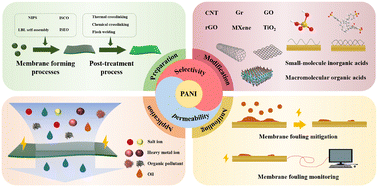Preparation, modification and antifouling properties of polyaniline conductive membranes for water treatment: a comprehensive review
Abstract
Membrane separation has made significant contributions to effective water treatment technology in the fields of resource recovery, desalination and wastewater treatment in recent years. However, problems such as concentration polarisation and membrane fouling limit its selectivity and permeability in separation. The rapid development of electrochemical technology and emerging preparation methods for conductive membranes have enhanced membrane separation technology. Polyaniline (PANI) is a conductive polymer, and it has shown great potential for use in water treatment due to its flexible tunability, acceptable electrochemical properties and low cost, which necessitate a comprehensive review. In this paper, the preparation and doping of PANI conductive membranes are described in detail from the introduction of PANI. The effects of preparation and doping methods on membrane properties are evaluated. In addition, the research on PANI conductive membranes for water treatment and antifouling applications is summarised. Finally, the main remaining problems are presented, and directions for further research are envisaged.

- This article is part of the themed collection: Environmental Science: Water Research & Technology Recent Review Articles


 Please wait while we load your content...
Please wait while we load your content...